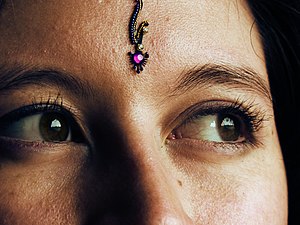Bindi (decoration)

A bindi (from Sanskrit bindu, meaning "a drop, small particle, dot") is a forehead decoration worn in South Asia (particularly India)[1] and Southeast Asia. Traditionally it is a dot of red color applied in the center of the forehead close to the eyebrows, but it can also consist of a sign or piece of jewelry worn at this location.
Modern use
Nowadays, bindis are worn throughout South Asia (India, Bangladesh, Nepal, Sri Lanka, and Pakistan) by women and girls, and no longer signify age, marital status, religious background, or ethnic affiliation.[2] The bindi has become a decorative item and is no longer restricted in colour or shape. Self-adhesive bindis (also known as sticker bindis) are available, usually made of felt or thin metal and adhesive on the other side. These are simple to apply, disposable substitutes for older tilak bindis. Sticker bindis come in many colors, designs, materials, and sizes. Fancier sticker bindis are decorated with sequins, glass beads, or rhinestones.
Outside South Asia, bindis are sometimes worn by women of Indian origin. Some Western women who have converted to Hinduism, such as in the Hare Krishnas, also wear bindis. Sometimes they are worn as a style statement. International celebrities such as Gwen Stefani, Shakira, Madonna, Nina Hagen, Nelly Furtado, and Shania Twain have been seen wearing bindis.
Alternative names of bindi


A bindi can be called:
- Tikli in Marathi
- Pottu in Tamil and Malayalam
- Tilak in Hindi
- Chandlo in Gujarati
- Bottu or Tilakam (in Telugu)
- Bottu or Tilaka (in Kannada)
- Teep (meaning "a pressing") (in Bengali)
- Nande is a term erroneously used to describe the bindi in Malaysia. It may contain pejorative connotations although not in most cases.
- A Paki dot in English. This is a racial slur (see Paki/Pakki).
Sometimes the terms sindoor, kumkum, or kasturi are used by reference to the material used to make the mark.
Religious significance
The area between the eyebrows (where the bindi is placed) is said to be the sixth chakra, ajna, the seat of "concealed wisdom". According to followers of Tantrism, this chakra is the exit point for kundalini energy. The bindi is said to retain energy and strengthen concentration. [3] It is also said to protect against demons or bad luck.
Related customs
In addition to the bindi, in India, a vermilion mark in the parting of the hair just above the forehead is worn by married women as a symbol of their married status. During North Indian marriage ceremonies, the groom applies sindoor on the parting in the bride's hair. Ancient Chinese women wore similar marks (for purely decorative purposes) since the second century, which became popular during the Tang Dynasty.

References
- ^ Hindu-Wearing
- ^ Parvesh Handa, "Home Beauty Clinic", Pustak Mahal, ISBN 8122300995
- ^ Das, Subhamoy. "Bindi: The Great Indian Forehead Art". Retrieved 2009-02-16.
External links
